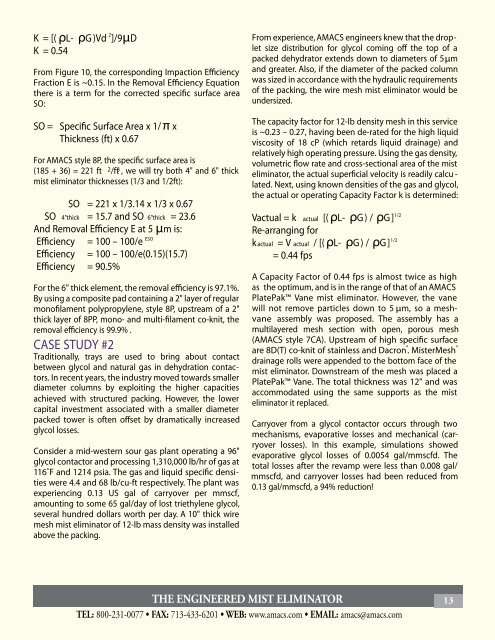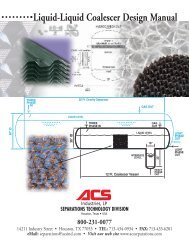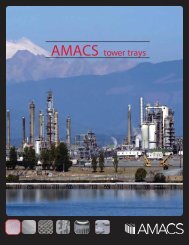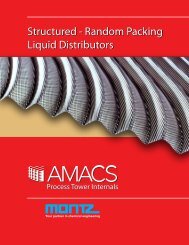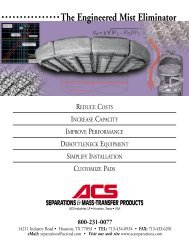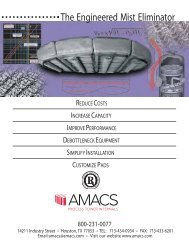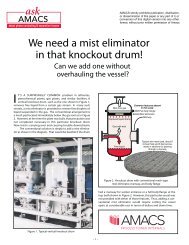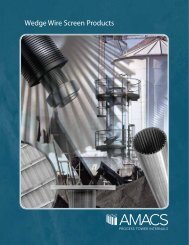The Engineered Mist Eliminator - AMACS Process Tower Internals
The Engineered Mist Eliminator - AMACS Process Tower Internals
The Engineered Mist Eliminator - AMACS Process Tower Internals
Create successful ePaper yourself
Turn your PDF publications into a flip-book with our unique Google optimized e-Paper software.
K = [( ρL- ρG )Vd 2 ]/9µDK = 0.54From Figure 10, the corresponding Impaction E ciencyFraction E is ~0.15. In the Removal E ciency Equationthere is a term for the corrected surface areaSO:SO =Surface Area x 1/π xThickness (ft) x 0.67For <strong>AMACS</strong> style 8P, the surface area is(185 + 36) = 221 ft 2/ft 3 , we will try both 4" and 6" thickmist eliminator thicknesses (1/3 and 1/2ft):SO = 221 x 1/3.14 x 1/3 x 0.67SO 4"thick = 15.7 and SO 6"thick = 23.6And RemovalE at 5 µm is:= 100 – 100/e ESO= 100 – 100/e(0.15)(15.7)= 90.5%For the 6" thick element, the removal e ciency is 97.1%.By using a composite pad containing a 2" layer of regularpolypropylene, style 8P, upstream of a 2"thick layer of 8PP, mono- andco-knit, theremoval e ciency is 99.9% .CASE STUDY #2Traditionally, trays are used to bring about contactbetween glycol and natural gas in dehydration contactors.In recent years, the industry moved towards smallerdiameter columns by exploiting the higher capacitiesachieved with structured packing. However, the lowercapital investment associated with a smaller diameterpacked tower is often o set by dramatically increasedglycol losses.Consider a mid-western sour gas plant operating a 96"glycol contactor and processing 1,310,000 lb/hr of gas at116˚F and 1214 psia. <strong>The</strong> gas and liquid densitieswere 4.4 and 68 lb/cu-ft respectively. <strong>The</strong> plant wasexperiencing 0.13 US gal of carryover per mmscf,amounting to some 65 gal/day of lost triethylene glycol,several hundred dollars worth per day. A 10" thick wiremesh mist eliminator of 12-lb mass density was installedabove the packing.From experience, <strong>AMACS</strong> engineers knew that the dropletsize distribution for glycol coming o the top of apacked dehydrator extends down to diameters of 5 µmand greater. Also, if the diameter of the packed columnwas sized in accordance with the hydraulic requirementsof the packing, the wire mesh mist eliminator would beundersized.<strong>The</strong> capacity factor for 12-lb density mesh in this serviceis ~0.23 – 0.27, having been de-rated for the high liquidviscosity of 18 cP (which retards liquid drainage) andrelatively high operating pressure. Using the gas density,volumetric rate and cross-sectional area of the misteliminator, the actual velocity is readily calcu -lated. Next, using known densities of the gas and glycol,the actual or operating Capacity Factor k is determined:Vactual = k actual [(ρL- ρG ) / ρG ] 1/2Re-arranging fork actual = V actual / [(ρL- ρG ) / ρG ] 1/2= 0.44 fpsA Capacity Factor of 0.44 fps is almost twice as highas the optimum, and is in the range of that of an <strong>AMACS</strong>PlatePak Vane mist eliminator. However, the vanewill not remove particles down to 5 µm, so a meshvaneassembly was proposed. <strong>The</strong> assembly has amultilayered mesh section with open, porous mesh(<strong>AMACS</strong> style 7CA). Upstream of high surfaceare 8D(T) co-knit of stainless and Dacron ® . <strong>Mist</strong>erMesh ®drainage rolls were appended to the bottom face of themist eliminator. Downstream of the mesh was placed aPlatePak Vane. <strong>The</strong> total thickness was 12" and wasaccommodated using the same supports as the misteliminator it replaced.Carryover from a glycol contactor occurs through twomechanisms, evaporative losses and mechanical (carryoverlosses). In this example, simulations showedevaporative glycol losses of 0.0054 gal/mmscfd. <strong>The</strong>total losses after the revamp were less than 0.008 gal/mmscfd, and carryover losses had been reduced from0.13 gal/mmscfd, a 94% reduction!THE ENGINEERED MIST ELIMINATOR 13TEL: 800-231-0077 • FAX: 713-433-6201 • WEB: www.amacs.com • EMAIL: amacs@amacs.com


